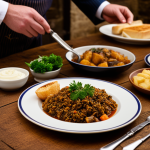Essential Tips for Enhanced Flavor in Beef Wellington
Delve into the art of building rich taste layers.
Choosing the right beef cut is crucial among beef Wellington tips. A center-cut beef fillet guarantees tenderness and savory depth, as it’s lean and delicate yet flavorful. Alternatives like sirloin can work but usually lack the characteristic succulence.
Also read : How can you create a perfect fish and chips at home?
To enrich flavor, focus on layering. Duxelles—a finely chopped mushroom mixture—forms the umami base, complemented by pâté (often foie gras or mushroom) which adds luxurious richness. Don’t underestimate seasoning; salt and pepper seasoning must be generous at every stage to enhance but not overwhelm.
Resting the cooked Wellington is a common overlooked step yet essential. Allowing the beef to rest retains juices, leading to tender, moist slices that truly elevate the eating experience. Precision in slicing then reveals beautiful pink beef, contrasting with golden pastry and savory layers.
Also read : What Are the Secrets Behind Traditional British Dishes?
Master these beef Wellington tips for a rich taste that excites the palate, blending texture and aromatic depth seamlessly.
Ingredient Selection for Superior Savory Results
Choosing the right beef Wellington ingredients is foundational for a truly savory dish. The premium choice is a center-cut beef fillet, prized for its tenderness and consistent texture, making it ideal for achieving that rich taste steak enthusiasts seek. Alternatives like sirloin or striploin can be used, but they generally lack the delicate juiciness of fillet.
Creating a perfect duxelles elevates the flavor profile. This mushroom mixture should be finely chopped and cooked slowly to evaporate moisture, intensifying its umami character. Using a combination of cremini and shiitake mushrooms enhances depth. Season the duxelles lightly with salt and a hint of garlic to balance earthiness.
Incorporating pâté and prosciutto adds layers of indulgent flavor. Foie gras pâté offers a luxurious, buttery richness, while mushroom or chicken liver pâté provides subtle complexity. Prosciutto wraps the duxelles and beef, imparting saltiness and helping keep moisture in check during cooking. Choosing these ingredients thoughtfully is a critical step among beef Wellington tips for enhancing flavor and securing a rich taste foundation.
Mastering Pastry Techniques for Beef Wellington
Achieving a crisp, golden pastry for beef Wellington is essential to balance the rich filling. Start by handling puff pastry with care—keep it cold and avoid overworking to maintain its flakiness. Roll the dough evenly to about 3mm thickness, ensuring a uniform bake and preventing soggy spots.
Proper wrapping techniques are vital. Enclose the beef fillet and duxelles layer snugly to trap moisture inside but avoid excess filling leaking out. Using prosciutto helps create a moisture barrier, protecting the pastry from becoming soggy. Seal edges firmly to hold the shape during cooking.
Chilling the wrapped Wellington before baking is a game-changer. It firms the pastry, reducing shrinkage and preventing filling juices from seeping through. An egg wash applied just before baking promotes a shiny, appealing golden crust.
Together, these pastry for beef Wellington strategies ensure a satisfying texture contrast—crispy crust with tender meat inside—crucial for enhancing flavor and delivering a show-stopping dish.
Seasoning and Layering for Savory Depth
Careful seasoning beef Wellington is pivotal when enhancing flavor. Each layer—from the beef fillet to the duxelles and pâté—deserves attention with salt and pepper. Salt enhances natural juices, while pepper adds gentle heat. Seasoning early allows flavors to meld deeply during cooking.
Incorporating herbs and spices can elevate a gourmet beef Wellington beyond basic savory tones. Thyme and rosemary, added to the duxelles or brushed onto the beef before searing, impart aromatic complexity. A pinch of nutmeg or mustard powder in the duxelles adds subtle warmth without overpowering.
Finishing salts, sprinkled lightly after resting, can provide a delicate crunch and brightness to the rich layers. Avoid over-seasoning; balance is key to preserving the dish’s sophisticated layers of flavor.
Mistakes often arise when seasoning is inconsistent—under-seasoned filling yields blandness, while overseasoning masks natural beef taste. Layering seasoning at every stage ensures layers of flavor develop fully and harmoniously, making your beef Wellington a truly memorable dish.
Essential Tips for Enhanced Flavor in Beef Wellington
Mastering beef Wellington tips starts with selecting the ideal beef cut. The center-cut beef fillet is preferred for its tender texture and natural savoriness, delivering a consistently rich taste. This choice sets a foundation of premium flavor that other cuts rarely match.
To enhance flavor, focus on layering. A well-prepared duxelles infuses an earthy umami base, complemented by pâté that enriches the Wellington with buttery depth. Generous seasoning at every stage—on the beef, duxelles, and pâté—is critical for enhancing flavor without overpowering the natural tastes.
Resting the cooked Wellington is often overlooked but essential for juicy results. Allowing the meat to rest locks in juices, ensuring each slice is tender and moist. Precise slicing then reveals the contrast between the golden pastry and pink, succulent beef, creating a harmonious blend of texture and rich taste.
These tips provide a framework to build bold, layered flavors in your Wellington, transforming a classic dish into a sophisticated gourmet experience.
Essential Tips for Enhanced Flavor in Beef Wellington
Selecting the best beef cut is foundational among beef Wellington tips. The center-cut beef fillet offers unmatched tenderness and a natural, rich taste, thanks to its fine texture and moderate marbling. This choice maximizes savoriness and delivers consistently juicy results.
Building layers of flavor hinges on combining duxelles, pâté, and seasoning thoughtfully. The earthy depth of finely cooked duxelles pairs with the buttery richness of pâté, creating an umami-rich core. Seasoning each layer judiciously—salting the beef, flavoring duxelles, and seasoning pâté—ensures enhancing flavor without overpowering the delicate balance.
Resting the Wellington after cooking is often overlooked but essential. Allowing the beef to rest traps its juices, preventing dry, tough slices. This step ensures tender, moist meat that contrasts beautifully with the crisp pastry. Precise slicing then showcases the harmony of textures and the vibrant pink interior, completing the experience of a truly rich taste Wellington.



